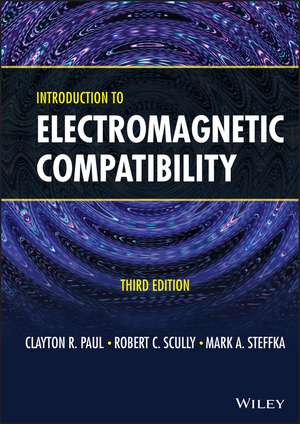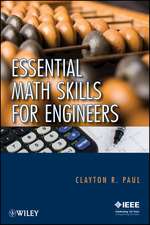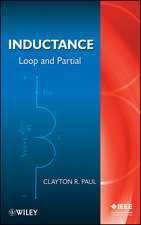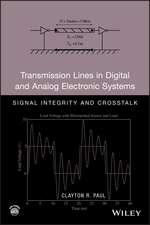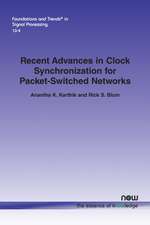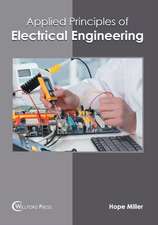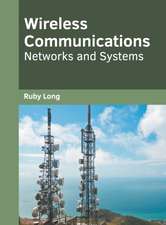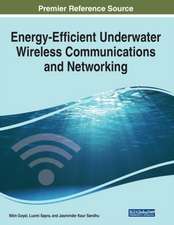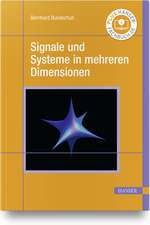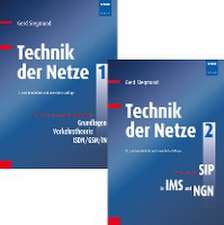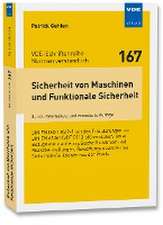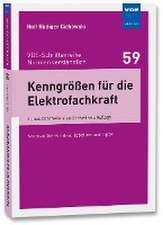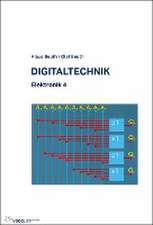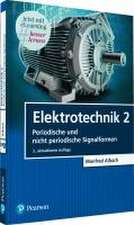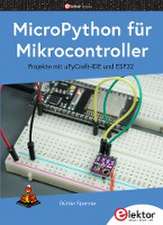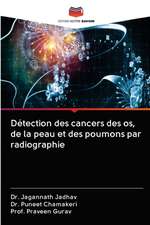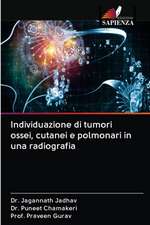Introduction to Electromagnetic Compatibility, Third Edition
Autor CR Paulen Limba Engleză Hardback – 6 noi 2022
Preț: 822.77 lei
Preț vechi: 1127.08 lei
-27% Nou
Puncte Express: 1234
Preț estimativ în valută:
157.45€ • 163.39$ • 131.61£
157.45€ • 163.39$ • 131.61£
Carte tipărită la comandă
Livrare economică 17-31 martie
Preluare comenzi: 021 569.72.76
Specificații
ISBN-13: 9781119404347
ISBN-10: 1119404347
Pagini: 848
Dimensiuni: 183 x 256 x 45 mm
Greutate: 1.41 kg
Ediția:3rd Edition
Editura: Wiley
Locul publicării:Hoboken, United States
ISBN-10: 1119404347
Pagini: 848
Dimensiuni: 183 x 256 x 45 mm
Greutate: 1.41 kg
Ediția:3rd Edition
Editura: Wiley
Locul publicării:Hoboken, United States
Cuprins
Preface xiii 1 Introduction to Electromagnetic Compatibility (EMC) 1 1.1 Aspects of EMC 2 1.2 Electrical Dimensions and Waves 9 1.3 Decibels and Common EMC Units 16 1.4 Summary 30 2 EMC Requirements for Electronic Systems 35 2.1 Governmental Requirements 36 2.2 Additional Product Requirements 62 2.3 Design Constraints for Products 63 2.4 Advantages of EMC Design 64 3 Signal Spectra--the Relationship between the Time Domain and the Frequency Domain 71 3.1 Periodic Signals 71 3.2 Spectra of Digital Waveforms 93 3.3 Spectrum Analyzers 113 3.4 Representation of Nonperiodic Waveforms 118 3.5 Representation of Random (Data) Signals 121 4 Transmission Lines and Signal Integrity 133 4.1 The Transmission-Line Equations 136 4.2 The Per-Unit-Length Parameters 139 4.3 The Time-Domain Solution 155 4.4 High-Speed Digital Interconnects and Signal Integrity 170 4.5 Sinusoidal Excitation of the Line and the Phasor Solution 192 4.6 Lumped-Circuit Approximate Models 210 5 Nonideal Behavior of Components 221 5.1 Wires 222 5.2 Printed Circuit Board (PCB) Lands 232 5.3 Effect of Component Leads 235 5.4 Resistors 237 5.5 Capacitors 243 5.6 Inductors 251 5.7 Ferromagnetic Materials--Saturation and Frequency Response 255 5.8 Ferrite Beads 258 5.9 Common-Mode Chokes 261 5.10 Electromechanical Devices 264 5.11 Digital Circuit Devices 269 5.12 Effect of Component Variability 270 5.13 Mechanical Switches 270 6 Conducted Emissions and Susceptibility 287 6.1 Measurement of Conducted Emissions 288 6.2 Power Supply Filters 294 6.3 Power Supplies 310 6.4 Power Supply and Filter Placement 319 6.5 Conducted Susceptibility 321 7 Antennas 325 7.1 Elemental Dipole Antennas 325 7.2 The Half-Wave Dipole and Quarter-Wave Monopole Antennas 332 7.3 Antenna Arrays 342 7.4 Characterization of Antennas 349 7.5 The FRIIs Transmission Equation 365 7.6 Effects of Reflections 368 7.7 Broadband Measurement Antennas 381 7.8 Antenna Modeling and Simulation 388 8 Radiated Emissions and Susceptibility 397 8.1 Simple Emission Models for Wires and PCB Lands 398 8.2 Simple Susceptibility Models for Wires and PCB Lands 423 9 Crosstalk 445 9.1 Three-Conductor Transmission Lines and Crosstalk 446 9.2 The Transmission-Line Equations for Lossless Lines 449 9.3 The Per-Unit-Length Parameters 452 9.4 The Inductive--Capacitive Coupling Approximate Model 476 9.5 Shielded Wires 500 9.6 Twisted Wires 529 10 Shielding 557 10.1 Shielding Effectiveness 561 10.2 Shielding Effectiveness: Far-Field Sources 563 10.3 Shielding Effectiveness: Near-Field Sources 576 10.4 Low-Frequency, Magnetic Field Shielding 581 10.5 Effects of Apertures 585 11 System Design for EMC 593 11.1 Changing the Way we Think About Electrical Phenomena 597 11.2 What do we Mean by the Term "Ground" 605 11.3 Printed Circuit Board (PCB) Design 636 11.4 System Configuration and Design 655 11.5 Diagnostic Tools 672 Appendix A The Phasor Solution Method 683 A.1 Solving Differential Equations for their Sinusoidal, Steady-State Solution 683 A.2 Solving Electric Circuits for Their Sinusoidal, Steady-State Response 687 Appendix B The Electromagnetic Field Equations and Waves 693 B.1 Vector Analysis 694 B.2 Maxwell's Equations 701 B.3 Boundary Conditions 720 B.4 Sinusoidal Steady State 724 B.5 Power Flow 725 B.6 Uniform Plane Waves 726 B.7 Static (DC) Electromagnetic Field Relations--a Special Case 741 Appendix C Computer Codes for Calculating the Per-Unit-Length (PUL) Parameters and Crosstalk of Multiconductor Transmission Lines 753 C.1 WIDESEP.FOR for Computing the PUL Parameter Matrices of Widely Spaced Wires 754 C.2 RIBBON.FOR for Computing the PUL Parameter Matrices of Ribbon Cables 758 C.3 PCB.FOR for Computing The PUL Parameter Matrices of Printed Circuit Boards 760 C.4 MSTRP.FOR for Computing the PUL Parameter Matrices of Coupled Microstrip Lines 761 C.5 STRPLINE.FOR for Computing the PUL Parameter Matrices of Coupled Striplines 762 Appendix D A Spice (PSPICE, LTSPICE, etc.) Tutorial and Applications Guide 765 D.1 Creating a Spice or Pspice Simulation 766 D.2 Creating an Ltspice Simulation 777 D.3 Lumped-Circuit Approximate Models 785 D.4 An Exact Spice (Pspice) Model for Lossless, Coupled Lines 788 D.5 Use of Spice (Pspice) in Fourier Analysis 805 D.6 Spicemtl.For for Computing a Spice (Pspice) Subcircuit Model of a Lossless, Multiconductor Transmission Line 815 D.7 Spicelpi.For for Computing a Spice (Pspice) Subcircuit of a Lumped-Pi Model of a Lossless, Multiconductor Transmission Line 817 Problems 818 References 820 Appendix E A Brief History of Electromagnetic Compatibility 823 E.1 History of EMC 823 E.2 Examples 825 Index 827
Notă biografică
Clayton R. Paul was Professor and Sam Nunn Chair of Aerospace Systems Engineering at Mercer University and Emeritus Professor of Electrical Engineering at the University of Kentucky, where he served on the faculty for 27 years. Dr. Paul authored twelve textbooks and published numerous technical papers in scientific journals and symposia. He was a Fellow of the IEEE and Honorary Life Member of the IEEE EMC Society. Robert C. Scully a Principal Electromagnetic Compatibility Engineer, practicing at Jet Propulsion Laboratory (JPL) in Pasadena, CA., previously the Johnson Space Center (JSC) Electromagnetic Compatibility Group Lead Engineer for 20 years. He earned his PhD in Electrical Engineering from the University of Texas at Arlington, USA, and is a Fellow of the IEEE. At JSC, he supported NASA's major space programs including the Space Shuttle, the International Space Station, the Multi-Purpose Crew Vehicle, the Commercial Crew Development Program, and the Gateway Program. At JPL he is currently supporting development of major satellite projects including NISAR and Europa. Mark A. Steffka is a Professor at the University of Detroit-Mercy. He joined the Electrical and Computer Engineering department as a full-time faculty member after his retirement from General Motors, where spent 20 years in the EMC Group. He received his B.S.E.E. from the University of Michigan and his M.S. from Indiana Wesleyan University. He has over 35 years' experience in the design, development, and testing of military communication systems, aerospace instrumentation, automotive electrical/electronic systems, and vehicle antennas. Steffka is a Senior Member of the IEEE and has co-authored / authored many publications on EMC, Radio Frequency Interference and more.
